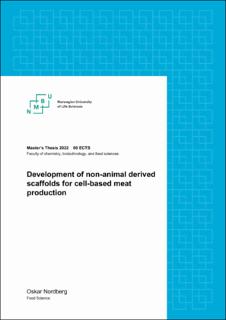| dc.contributor.advisor | Sissel Beate Rønning - Nofima | |
| dc.contributor.advisor | Mona Elisabeth Pedersen - Nofima | |
| dc.contributor.advisor | Vincent Eijsink - NMBU | |
| dc.contributor.author | Nordberg, Oskar Mathias Laumann | |
| dc.date.accessioned | 2023-05-04T16:27:16Z | |
| dc.date.available | 2023-05-04T16:27:16Z | |
| dc.date.issued | 2022 | |
| dc.identifier | no.nmbu:wiseflow:6726895:52495794 | |
| dc.identifier.uri | https://hdl.handle.net/11250/3066234 | |
| dc.description.abstract | Den stadig økende globale befolkningen vil, sammen med en økende middelklasse, føre til en økt etterspørsel av kjøtt og kjøttprodukter i framtiden. Det må utvikles nye bærekraftige måter å produsere kjøtt på siden dagens kjøttproduksjon har en stor, negative belastning på klima og miljøet. Etter Mark J. Post lagde den første laboratorie-lagde hamburgeren i 2013, har ytterlige aktører meldt seg på i feltet. I Indonesia selges det i dag kylling nuggets laget ved bruk av cellebasert teknologi, og UPSIDE Foods i USA har fått godkjenning på sin søknad om GRAS-status for sin teknologi fra FDA. Det gjenstår fremdeles en del forskning for å håndtere oppskaleringen fra laboratorieforsøk til masseproduksjon, men skritt tas i riktig retning.
Hovedmålet med denne studien var å utvikle spiselige scaffolds som ikke er laget av materialer fra dyr. Vi produserte 2 typer scaffolds: I) proteinbaserte scaffolds fra ekstrudert soya og faba bønner, II) bakteriell nanocellulose fra Kombucha bakterier. Bovine muskelceller ble sådd ut på disse scaffoldene. I tillegg sammenlignet vi om modifisering med ekstracellulære proteiner (entactin, laminin, collagen) kunne forbedre celleveksten på de ulike scaffoldene. Adhesjon, proliferasjon og differensiering av cellene på BNC ble analysert ved immunfluoriserende mikroskopi og kvantifisert ved RT-qPCR analyse av mRNA fra myogenfaktorene Pax7, MyoD1, myogenin, differensieringsmarkøren desmin, celleadhesjonsmarkørene ITGβ5 og SDC4, og cytoskjelett/ fokal adhesjonsmørkøren VCL. Celler sådd ut på BNC som ikke prolifererte videre, ble etter 30 dager inkubasjon ble trypsinert av og sådd ut i ECL-belagte brønner for å undersøke om de fortsatt hadde proliferasjon- og differensieringspotensiale. Celle adhesjon på scaffolds av soya og åkerbønne ble analysert ved immunfluoriserende mikroskopi.
Resultatene viste at cellene klarte å feste seg til begge typer scaffold, og proliferere og differensiere på BNC scaffold uten ECL. På scaffold av åkerbønne økte antallet celler med ECL, mens på scaffold av soya var det ingen forskjell. Celler sådd ut på ECL-belagt BNC viste tegn til økt proliferasjon og differensiering sammenlignet med scaffold uten ECL-belegg. Det ble konkludert med at begge scaffold viser potensiale for å brukes i cellebasert kjøtt produksjon, men porøse scaffold fra soya og åkerbønne har noen utfordringer med tekniske egenskaper og sterilitet som må løses før videre forsøk kan utføres. | |
| dc.description.abstract | The increasing global population, together with an increasing middle class, will lead to an increased demand for meat and meat products in the future. As the production of meat is a major burden on the climate, new sustainable ways of producing meat must be developed. After Mark J. Post made the first laboratory-made hamburger in 2013, additional companies have signed in the pursuit of developing cell-based meat products. In Indonesia, chicken nuggets made using cell-based technology are now sold, and UPSIDE Foods in the USA has received approval for their application for GRAS-status on their technology from the FDA. There is still a lot of research before being able to handle the scale-up from laboratory trials to mass production, but progress is being made in the right direction.
The main goal of this study was to develop edible scaffolds that are non-animal derived.
We developed 2 types of scaffolds: I) protein-based scaffolds from textured soy and faba beans, II) bacterial nanocellulose from Kombucha bacteria. Bovine muscle cells were seeded onto these scaffolds. In addition, we compared whether modification with extracellular proteins (entactin, laminin, collagen) could improve cell growth on the various scaffolds. Adhesion, proliferation, and differentiation of the cells on BNC were analyzed by immunofluorescence microscopy and quantified by RT-qPCR analysis of mRNA expression in the myogenic factors Pax7, MyoD1, myogenin, the differentiation marker desmin, the cell adhesion markers ITGβ5 and SDC4, and the cytoskeleton/focal adhesion marker VCL. Cells seeded on BNC that did not proliferate further, were after 30 days incubation trypzinated off and seeded into ECL-coated wells to examine whether they still had proliferation and differentiation potential. Cell adhesion on scaffolds of soy and faba bean was analyzed by immunofluorescence microscopy.
The results showed that the cells were able to adhere to both types of scaffold, and to proliferate and differentiate on the BNC scaffold without ECL. On the faba bean scaffold the number of cells increased with ECL, while on the soy scaffold there was no difference. Cells seeded on ECL-coated BNC showed signs of increased proliferation and differentiation compared to the scaffold without ECL coating. It was concluded that both scaffolds show potential to be used in cell-based meat production, but porous scaffolds from textured soy and faba bean have some challenges with technical abilities and sterility that must be resolved before further trials can be carried out. | |
| dc.language | eng | |
| dc.publisher | Norwegian University of Life Sciences | |
| dc.title | Development of non-animal derived scaffolds for cell-based meat production | |
| dc.type | Master thesis | |
